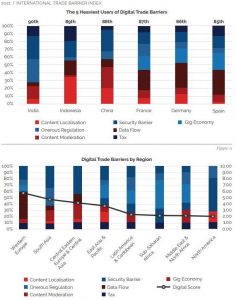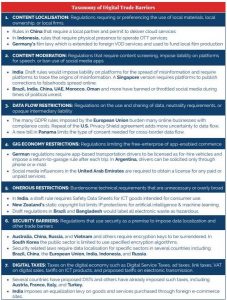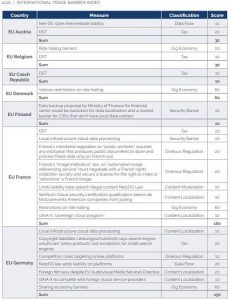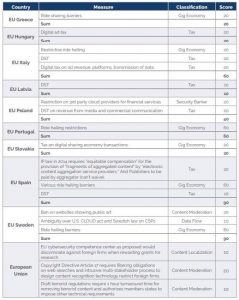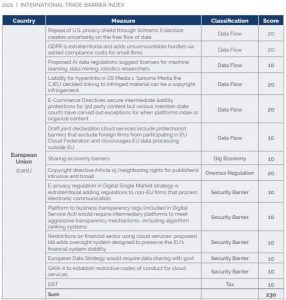The Property Rights Alliance has just published the “International Trade Barrier Index (TBI)”, assessing how trade barriers have evolved in the context of the Covid crisis, which erupted in early 2020.
The Index was first published in 2019 and provides data on tariffs, non-tariff measures, services restrictions, and the trade facilitation environment for 86 countries. It has beens developed in cooperation with the Tholos foundation. According to the authors, it is “designed to be used as tool for policymakers, business communities, and civic activists to highlight the harms cause by trade barriers and the net befits to be gained from reducing them. More than the sum of its parts, free trade, unhampered by artificial restraints, allows individuals to exchange ideas, social customs, goods, and services on mutually beneficial terms they determine. It rewards the most efficient allocation of resources and celebrates specialization.”
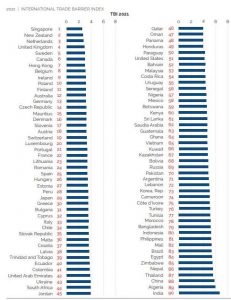
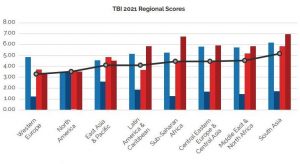
Some conclusions, as put by trade expert Daniel Griswold, affilated with the Mercatus Center at George Mason University:
“The 2021 TBI results confirm once again that Adam Smith was on to something: nations tend to become more prosperous as they shed barriers to trade, whether tariffs or non-tariff barriers. It is no random matter that the nations with the lowest barriers according to the 2021 TBI—Singapore, New Zealand, the Netherlands, the United Kingdom, Sweden, and Canada–are also among the most free and prosperous in the world.”
India again ranked the lowest on #TBI2021 for their severe trade restrictions, followed by Algeria and China. India and China together deploy the most tariffs, services restrictions, and non-tariff barriers.
Read the full report here: https://t.co/TyWioh16fR pic.twitter.com/WnIVYo0C8e
— PRA (@PRAlliance) October 21, 2021
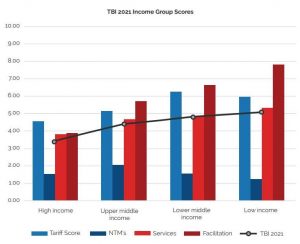
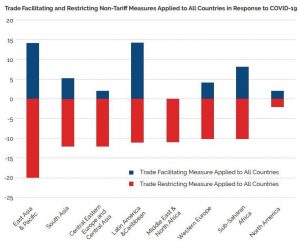
“One of the most newsworthy insights of the 2021 TBI, is the remarkable progress of the United Kingdom in lowering its own trade barriers after Brexit. Once the UK exited the EU’s common external tariff at the beginning of 2020, it embarked on one of the world’s most ambitious efforts at unilateral trade liberalization. With its new UK Global Tariff, the nation slashed hundreds of tariff lines to zero and signed 60 liberalizing trade agreements. As a result, the UK jumped from 8th to 4th in the TBI rankings. Meanwhile, the United States languishes far down the TBI rankings, challenging the myth that it is one of the most open economies in the world.“
Britain Rises from Eighth Place to Fourth Place on International Trade Barrier Index https://t.co/3os1SDcYPh pic.twitter.com/a117tfGbhH
— Euro Guido (@EuroGuido) October 21, 2021
“The TBI authors find a strong positive correlation between low barriers to trade and broader measures of civil and political freedom. More open economies also tend to be less corrupt. In the latest example of how freedoms are intertwined, the recent crackdown on civil liberties in Hong Kong has been accompanied by a measurable decline in its ranking in the TBI.”
”On the positive side, the 2021 TBI confirms that global tariffs have not been rising. In fact, in response to COVID-19, a number of countries lowered or eliminated tariffs on related medical supplies and equipment. Many countries also relaxed restrictions on digital trade.”
”On the negative side, COVID-19 also prompted countries to raise regulatory barriers to trade. On digital trade, the EU tightened its rules with its misguided General Data Protection Regulation while less developed countries such as India, Indonesia, and China imposed new rules on content, encryption, and data localization for servers. The United States contributed to the backsliding with administrative tariffs on steel and aluminum and imports from China.”
#TBI2021 finds that digital trade barriers increased dramatically since 2019––especially in Europe and Asia––due in part to the EU’s Digital Markets Act, Digital Services Act, and Digital Services Taxes.
Read the full report here: https://t.co/TyWioh16fR pic.twitter.com/dPiCtg2O1J
— PRA (@PRAlliance) October 21, 2021
.@Phili_Thomp highlights the seven components of digital regulation included in #TBI2021: Content localisation, content moderation, data flow restrictions, gig economy restrictions, onerous restrictions, security barriers, and digital taxes.
WATCH: https://t.co/Ux9osWz0iR
— PRA (@PRAlliance) October 21, 2021
Covid
The report also takes a specific look at how countries behaved during the Covid crisis, checking – on the basis of UNCTAD data – whether countries used so-called non-tariff measures (NTMs) to either facilitate or restrict trade.

The report notes that “Specifically, India, Turkey, Korea, and Vietnam implemented the most trade restrictions on COVID-19 related products. These were largely export prohibitions, export licenses, or authorization requirements to export items such as: hydroxychloroquine, diagnostics tools, test kits, sanitizers, and masks.
Other common restrictions were SPS measures that restricted imports of live animals, fruit, and for certain countries shoes and second hand clothes—ostensibly to prevent the unintentional import of the COVID-19 virus. Consistent with the TBI, many of these countries are heavy users of NTMs generally. An exception to this rule was the United States, which waived some existing NTMs on medical products.”
“On the other hand, East Asia and Latin America & the Caribbean led in implementing trade facilitating measures for COVID-19 products. While states that heavily manage trade such as Indonesia, Brazil, and Argentina led in implementing trade facilitating measures to ease the burden of COVID-19 related supplies coming into their country, they also added trade restrictions to keep them from leaving. By far, the most common facilitating measure was to waive tax and duty charges for COVID-19 related medical products, followed by financial relief for importing businesses.”
Services
On services, the report concludes “there is a clear relationship between open services trade and membership in higher income groups.”
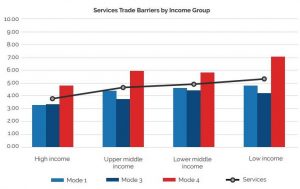
Digital trade barriers: highest in Western Europe
The report remarks that “Despite trade wars conducted by the United States to confront China over unfair trade practices and on countries that export steel and aluminum, North America managed to be the most improved in the Facilitation category.
This is due in part to the U.S. refraining from digital trade barriers, improvement in logistics for both Canada and the United States, as well as Canada signing one more trade agreement with the UK.”
The report notes that calculating “Digital Trade Barriers” “consists of quantifying the number of regulations that are proposed and implemented that can be classified as one of seven digital trade barriers: content localisation, content moderation, data flow barriers, security barriers, digital taxes, gig economy barriers, or other onerous regulations.”
The report highlights how Western Europe is not only burdened with the highest level of digital trade barriers. Between 2019 and 2021, the greatest deterioration was also visible is in Western Europe, due to regulations like EU GDPR.
“Overall, India, Indonesia, and China impose the most digital trade barriers, relying heavily on content moderation, backdoor encryption keys, and data localisation for servers (Figure 11). As a region, Western Europe (Figure 12) takes the lead. This is due to Europe’s General Data Protection Regulation (GDPR), Digital Markets Act, Digital Services Act, and Digital Services Taxes (DSTs). These measures include numerous regulations that impose significant barriers including content moderation, restrictions on how and what type of data can cross borders, and taxes”.
